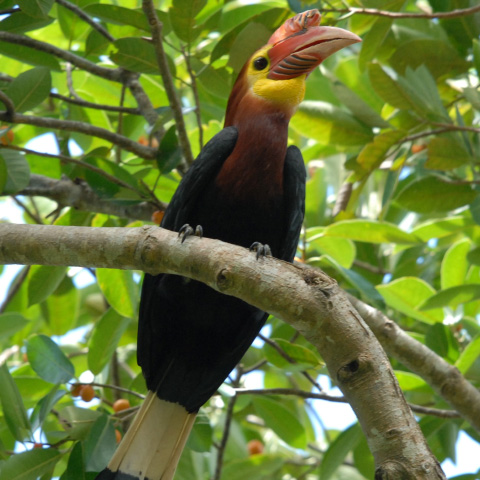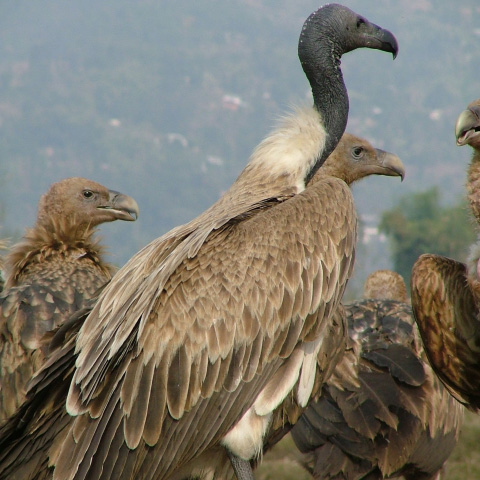Conservation Actions
Conservation and research actions underway
CMS Appendix I; It was included in the African-Eurasian Migratory Landbirds Action Plan (AEMLAP) (African-Eurasian Migratory Landbirds Working Group 2014). It is counted occasionally as part of on-going IBA monitoring in a few sites. After media exposure of the crisis there was an attempt to clamp down on illegal trade in this species (S. Chan in litt. 2013), but this practice likely still persists (see Kamp et al. 2015). There is ongoing research on Sakhalin to find out if difference in migration strategies (e. g. key stopover and wintering sites) is responsible for contrasting sustainability of different populations. The study uses stable isotopes sampled from free-ranging birds and collection specimens, and geologger tracking of sustainable populations. (P. Ktitorov in litt. 2017).
Conservation and research actions proposed
Implement a programme of co-ordinated range-wide monitoring at breeding, passage and non-breeding sites, in order to quantify the rate of decline. Through awareness campaigns, reduce the demand for the species as a food item, mascot and merit-bird. Research its precise habitat requirements on the wintering grounds. Protect sites which still hold large numbers on the wintering grounds. Better enforce legislation against illegal trapping and trade (J. Kamp in litt. 2016).
Location Information
This species once bred across the northern Palaearctic from Finland, Belarus and Ukraine in the west, through Kazakhstan, China and Mongolia, to far eastern Russia, Korea and northern Japan. However, after a precipitous decline it is now thought to have potentially completely disappeared from Finland, Belarus, Ukraine and large parts of Russia (Kamp et al. 2015). In the autumn, birds stop-over in large numbers to moult in the Yangtze Valley, China, before continuing on to their winter quarters. It winters in a relatively small region in South and South-East Asia, which includes eastern Nepal, north-eastern India, Bangladesh, Myanmar, southern China, Cambodia, Laos, Vietnam and Thailand (Byers et al. 1995). It was formerly one of the most abundant breeding passerines across vast swathes of Siberia, but although there have been no systematic surveys, a severe decline has been noted in most breeding areas and it has completely disappeared from parts of its former breeding range since the early 1990s (Kamp et al. 2015). No birds have been recorded breeding in Finland since 2009, and its range has contracted northwards by 300 km in Kazakhstan since the late 1990s, although it does persist in some areas of Kazakhstan, such as along the Irtysh river near Irtyshsk (R. Ayé in litt. 2013). It is estimated to have declined by 95-99% in European Russia between 2000 and 2012 (BirdLife International 2015).
Declines have been reported in the Moscow, Novgorod, Kostroma, Ulyanovsk and Baikal regions (A. Mischenko in litt. 2012), whilst very rapid declines in the Tyumen region were reported in 2011 (J. Kamp in litt. 2012), suggesting a massive decline in the core range (M. Flade in litt. 2007). Surveys in 2012 and 2013 suggest that the species has nearly or completely disappeared from Tyumen province in Western Siberia, which appears consistent with an impression of a steep decline across Western Siberia (J. Kamp et al. in litt. 2013). In contrast, recent surveys within and outside protected areas in Amur and Chabarovsk regions, suggest that the species is faring better in the east of its breeding range, with an estimate of 100-150 breeding pairs in Muraviovka Park (c.6,500 ha) in 2013, although anecdotal evidence indicates a decline in these areas since the 1990s (J. Kamp et al. in litt. 2013). Severe declines have also been noted in Hokkaido, Japan and Mongolia (Tamada et al. 2014, S. Chan and O. Goroshko in litt. 2003, Tamada 2006, M. Gilbert, A. Mischenko and J. Kamp in litt. 2007). Kamp et al. (2015) have estimated that between 1980 and 2013 the population may have declined by 84.3-94.7%, with an eastwards range retraction of 5,000 km.
It no longer occurs in "swarms" at migration watch-points such as Beidaihe, China, and although a range-wide survey is required, numbers at wintering sites throughout its range have also shown rapid declines over the last twenty years (S. Chan, M. Williams, J. W. Duckworth and N. Moores in litt. 2003, T. Evans, M. Gilbert, M. Williams and S. Chan in litt. 2007). Based on evidence from wintering grounds in Cambodia the species is said to be clearly declining (T. Gray in litt. 2013). Historically, it was noted to be common on the central plain, but is now considered scarce away from the Tonle Sap area, and surveys of birds used in "merit releases" at Phnom Penh riverfront suggest a steep decline in this species since the mid-1990s in the Mekong-Bassac floodplain, where most merit-bird trappers operate (F. Goes in litt. 2013). Furthermore, there has been a lack of records from south-eastern Cambodia since the late 1990s, suggesting that it is very rare and perhaps close to extirpation in that region (F. Goes in litt. 2013). In Nepal, declines in the population and number of localities occupied have been noted since 1990 (C. Inskipp and H. S. Baral in litt. 2013, Inskipp et al. 2016). It also appears to have declined at the Hail Haor wetland in north-eastern Bangladesh since the mid-1980s (P. Thompson in litt. 2013, 2017). It should be noted that interpretation of the species's status in its non-breeding range based on the usually fragmentary information available is hindered by the erratic appearance of very large flocks (J. W. Duckworth in litt. 2013).
Geographic Range
Extant
Bahrain, Bangladesh, Belarus, Belgium, Brunei Darussalam, Cambodia, China, Cyprus, Czechia, Denmark, Egypt, Estonia, France, Germany, Greece, Hong Kong, India, Iran, Islamic Republic of, Ireland, Israel, Italy, Japan, Jordan, Kazakhstan, Korea, Democratic People's Republic of, Korea, Republic of, Lao People's Democratic Republic, Latvia, Malaysia, Malta, Mongolia, Myanmar, Nepal, Netherlands, Norway, Oman, Pakistan, Philippines, Poland, Portugal, Russian Federation, Saudi Arabia, Singapore, Spain, Sweden, Syrian Arab Republic, Taiwan, Province of China, Thailand, Türkiye, United Arab Emirates, United Kingdom of Great Britain and Northern Ireland, United States of America, Viet Nam
Possibly Extinct
Finland
Population Information
In Europe, the breeding population was estimated to number 20,000-100,000 breeding pairs, equating to 60,000-300,000 individuals (BirdLife International 2004). Europe, at least formerly, formed 25-49% of the global range. The European population is now estimated to number just 120-600 mature individuals (BirdLife International 2015).
Threats
Since many populations on pristine breeding grounds have dropped rapidly, the decline is likely to be driven by excessive trapping at migration and, in particular, wintering sites (Kamp et al. 2015, S. Chan in litt. 2003, 2007, P. Round in litt. 2003, M. Williams in litt. 2007). Roosting flocks in reedbeds are disturbed and then caught in mist-nets, they are cooked and sold as "sparrows" or "rice-birds"; this practice was formerly restricted to a small area of southern China, but has now become more widespread and popular owing to increasing affluence, and hunters now have to travel widely to find sufficient birds (M. Lau in litt. 2007, M. Williams in litt. 2007, S. Chan in litt. 2007). From 1992 onwards, an estimated several thousand individuals of this species were caught for the annual food festival in Sanshui City, southern China (Gao Yuren 1996). This practice was banned in 1997, but a black market in birds still persists and a huge number of birds are still sold annually (see Kamp et al. 2015), including around 10,000 birds sold daily in a single market in Sanshui (Chan 2004). In 2008, one shipment of 4,300 individuals of this species was reportedly confiscated in Zhejiang province en route to Guangdong province, and the species is said to remain a famous delicacy in southern China (per M. Zhang in litt. 2013). Likewise, the species is considered a delicacy in Cambodia (F. Goes in litt. 2013) and is trapped to be sold to restaurants in Nepal (C. Inskipp and H. S. Baral in litt. 2013). In China, thousands of males are also stuffed and sold as mascots, since their presence in the home is thought to confer happiness (A. Mischenko in litt. 2012). At least locally, for example in Cambodia, birds are trapped for "merit release" in temples (Gilbert et al. 2012, J. C. Eames in litt. 2007, F. Goes in litt. 2013).
Agricultural intensification, the shift to irrigated rice production and consequent loss of winter stubble has reduced the quality and quantity of wintering habitat, and the loss of reedbeds has reduced the number of available roost sites (T. Evans in litt. 2007, J. Tordoff in litt. 2007, J. C. Eames in litt. 2007). Declines caused by pressures on the wintering grounds are compounded by a reduction in habitat quality on the breeding grounds in parts of its range, particularly drying of meadows caused by changes in the flow pattern of rivers, a result of dam construction upstream (O. Goroshko in litt. 2003, J. Kamp in litt. 2007). Declines in Nepal have also been partly attributed to changes in agricultural practices since the 1980s, notably sharp increases in pesticide use (Inskipp and Baral 2011).
IUCN Red List Account Link
Please click here to see the species' IUCN Red List Account page.





